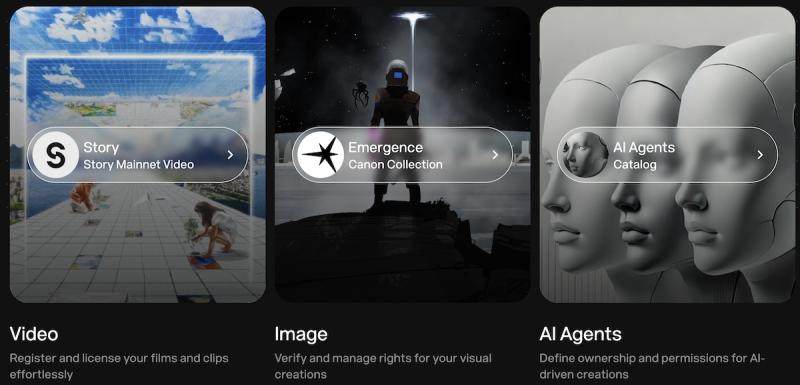The way we manage intellectual property hasn’t changed much in decades—and creators have paid the price. Murky licensing, unclear rights, and lost royalties have long been the norm. However, Web3 and smart contracts are rewriting the rules. Story Protocol offers a new model: a blockchain-native system where IP is transparent, traceable, and remixable by design—and where your creative work is protected, programmable, and profitable from day one.
Key Takeaways
-
Story Protocol allows rights and licensing terms to be embedded directly into blockchain-based assets, eliminating the need for manual rights management.
-
ERC-6551 token-bound accounts give each IP asset its own dynamic smart account capable of enforcing rules and executing transactions.
-
An open IP repository records the full lifecycle of creative works, from creation and remixing to monetization.
-
Smart contracts automate licensing and royalty splits, reducing legal friction and eliminating intermediaries.
-
Story Protocol’s mainnet launched in February 2025, following strong adoption during its testnet phase and over $134 million in venture backing from firms like a16z and Hashed.
What is Story Protocol?
Story Protocol is a purpose-built blockchain network developed by Seung Yoon Lee, Jason Zhao, and Jason Levy in 2022 to transform how intellectual property is handled in the digital age. It addresses licensing, rights disputes, and opaque royalty flows inefficiencies by introducing a programmable, decentralized IP layer.
At its core, Story Protocol turns any creative asset—text, video, music, code, or even AI models—into a composable and traceable on-chain entity. Ownership, usage permissions, and revenue sharing are all enforced via smart contracts.

Source Story Protocol
Key Features
Story Protocol includes several foundational components that work together to support decentralized, flexible, and automated IP management.
Smart Licensing Automation
Instead of relying on legal paperwork, creators define usage rules through embedded smart contracts—this streamlines licensing, monetization, and collaborative reuse—especially for derivative or community-generated content.
ERC-6551 Token-Bound Accounts
Each IP asset is minted as an NFT tied to a token-bound smart account. These ERC-6551 accounts—an Ethereum standard—enable assets to own other tokens, execute logic, and interact with decentralized applications.
Open IP Repository
Much like Git tracks software changes, Story Protocol logs every contribution to an IP asset—enhancing provenance and attribution. Users can track the full lifecycle of works, from creation to monetized remixing.
Modular Architecture
With modular plug-ins for licensing, remixing, or royalty enforcement, creators can customize their IP stack without relying on centralized gatekeepers.
Programmable IP License (PIL)
Story Protocol’s Programmable IP License (PIL) bridges blockchain rules with real-world enforceability, giving creators and enterprises legal certainty in both digital and traditional jurisdictions.
Benefits for Creators, Developers, and Enterprises
-
Creators can publish work, define licensing, and earn automatic royalties on derivative creations.
-
Developers can build apps that tap into the IP registry for storytelling tools, NFT games, or generative AI.
-
Enterprises gain access to legally licensed, verifiable IP data for training models or launching branded content, using a decentralized IP system that integrates digital rights management with smart contracts.
Use Cases in Action
-
Artists register characters or settings and allow spin-offs, while preserving credit and earnings.
-
AI developers can train models on IP-safe datasets, avoiding copyright violations.
-
Gaming platforms can track layered contributions and reward UGC creators dynamically.
During its testnet phase, Story Protocol recorded approximately 5 million daily transactions and gathered over 19 million active wallets. Since its February 2025 mainnet launch, its native IP token ($IP) has been listed on major exchanges and is used for governance, transaction fees, and creator rewards.
Frequently Asked Questions
How does Story Protocol differ from traditional IP systems?
Traditional IP systems require centralized oversight and legal contracts. Story Protocol automates licensing, enforcement, and attribution using smart contracts.
Can I remix or build on someone else’s work?
Yes—if the original creator allows it. Remix permissions and royalty splits are encoded on-chain, ensuring contributors are credited and compensated.
Is it legally binding?
Yes. Through the PIL framework, on-chain licensing terms are linked to real-world legal standards, ensuring enforceability across jurisdictions.
What types of assets can be registered?
Story Protocol supports text, video, music, images, software, and AI models—any form of digital content.
Final Thoughts
Story Protocol introduces new possibilities for a decentralized, transparent, and collaborative digital rights ecosystem. By combining programmable smart contracts, real-world legal alignment, and open participation, it lays the groundwork for a new era of Web3 content licensing, digital rights management, and decentralized IP infrastructure.
If this article, video or photo intrigues any copyright, please indicate it to the author’s email or in the comment box.

